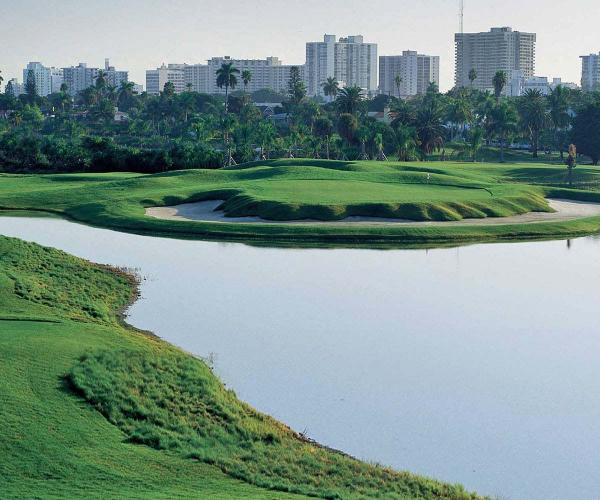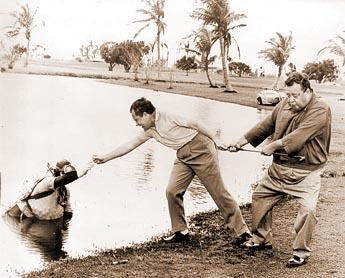When Jackie Gleason moved his weekly television show from New York to Miami Beach in 1964, he famously proclaimed at the opening of each broadcast that the city was "the sun and fun capital of the world."
 Gleason left an indelible mark on South Florida in the 1960s and 70s, and was a great ambassador for the game of golf, bringing the rich and famous and powerful to South Florida with him. But much has changed in the South Florida golf scene since Gleason hosted a PGA Tour event at Inverrary in Broward County throughout the 1970s.
Gleason left an indelible mark on South Florida in the 1960s and 70s, and was a great ambassador for the game of golf, bringing the rich and famous and powerful to South Florida with him. But much has changed in the South Florida golf scene since Gleason hosted a PGA Tour event at Inverrary in Broward County throughout the 1970s. When it comes to serving as a safe haven for immigrants seeking a better life, Miami has a longer history than most U.S. cities. As golf course operators around the country search for ways to attract a growing immigrant population, those in Miami also have more experience than most. But like their colleagues in other areas, Miami operators also struggle to attract non-native Americans to the game.
But instead of thinking there is something wrong with the game that warrants looking outside the ropes to other activities to attract people to the golf course, operators here have a different opinion on why golf is not attracting new players, at least those from minority communities.
"This is not an ethnic or racial issue," said Alberto Pozzi, who manages three municipal properties in Miami-Dade County. "This is a socio-economic issue.
"When minorities are doing well financially they play golf. There are waves of wealthy South Americans coming to Miami, and those who come at a high socio-economic level play a lot of golf. But the majority of immigrants coming into this country are starting at the bottom. Recreation is not a priority for immigrants unless they are well established economically."
Pozzi is a native of Uruguay who has lived in South Florida since 1977, and it appears there is merit to his claims that a stronger economy can go much farther than FootGolf toward improving the golf industry. He points to the U.S. Cuban American Golf Association in Miami-Dade County and similar groups for those from other Latin American countries as proof that the game has cross-cultural appeal. He says Miami has been the proverbial canary in the coal mine regarding the relationship between golf and immigrant populations in that the challenges others are seeing in recent years have been prevalent in Miami for decades.
Of course, no one seems to hold the secret to an improved economy either, or if they do, they certainly are not sharing it, making the plight of golf courses in Miami as real as those in other parts of the country.
"Miami is a microcosm of the industry as a whole," Pozzi said. "It's a precursor of trends that are now showing up in other parts of the country. Those trends started here many years ago. We have a large immigrant population, we are undergoing urban revitalization, but there has been no increase in the golfer population."
There is little current reliable data available on minority participation in golf. The National Golf Foundation's last published report on the topic is 6 years old. A more recent NGF report on golf participation indicates that of the estimated 19.5 million golfers in the U.S., 4.7 million are thought to be non-caucasian, according to NGF. That's the lowest number in nearly a decade.
Although information on the relationship between minorities and golf is hard to come by, Pozzi is on top of the trends that influence the golf business in South Florida. As the manager of three city-owned properties, he has to be. Pozzi operates Miami Shores Country Club in Miami Shores and Normandy Shores Golf Club and Miami Beach Golf Club, both in Miami Beach, and he says about 25 courses in Miami-Dade and Broward counties have closed in the past decade.
 "It is a necessity now to know the trends and what is going on in the market all the time; what drives it; what your competitors are doing," Pozzi said. "You have to learn from the guy next door. Is he doing something creative or better than you are?"
"It is a necessity now to know the trends and what is going on in the market all the time; what drives it; what your competitors are doing," Pozzi said. "You have to learn from the guy next door. Is he doing something creative or better than you are?"Dade County once was a popular destination for the rich and famous as well as northern snowbirds, but no more.
Those snowbirds began moving northward along the coast in the 1970s, first to Fort Lauderdale, and now to places like Boca Raton, Delray Beach, West Palm, and even Stuart and Vero Beach. Although the tourist industry is still strong, those coming to Miami are now coming for a few days to a week rather than for three or four months. And they are coming from overseas, not northern U.S. cities. Of Miami-Dade County's 2.7 million residents, more than 60 percent are foreign born, according to the Center for Immigration Studies. The city's population has been more than 50 percent foreign born since the late 1980s.
"The heyday of Miami in the '60s and '70s of golf was driven primarily by snowbirds from the Midwest and Northeast retiring in Dade and Broward counties. That trend slowed in the late '70s and virtually stopped by the late '80s," Pozzi said. "Miami-Dade is no longer a magnet for retirees from the Northeast, and that has affected the golf industry significantly."
Today, only 13 daily fee facilities, four equity clubs and a handful of resort properties like the Biltmore and Doral, where even the Greg Norman-designed White Course closed and was sold earlier this year for development.
The courses that remain open are doing OK financially. Pozzi believes a revival of the golf business in South Florida will come, not as more facilities convert to FootGolf, but as the immigrant population becomes more acclimated and their lot improves financially.
"If you change the focus of what you are offering, then you become something else," he said. "Not that I am a traditionalist, but at what point do you become so inviting to other non-traditional golf activities just to get people to the golf course that you compromise what you are about? If you do that with something like FootGolf, then you're not a golf course anymore.
"I sound like a doomsayer sometimes in this industry, but those facilities that remain have benefitted by the trend of golf course closures. We are thriving and doing well because we are benefitting by others closing. We are understanding the new trends and what is happening in the marketplace. I think the immigrant population eventually will get around to embracing golf in the same numbers that native Americans do, but there is some lag time."

